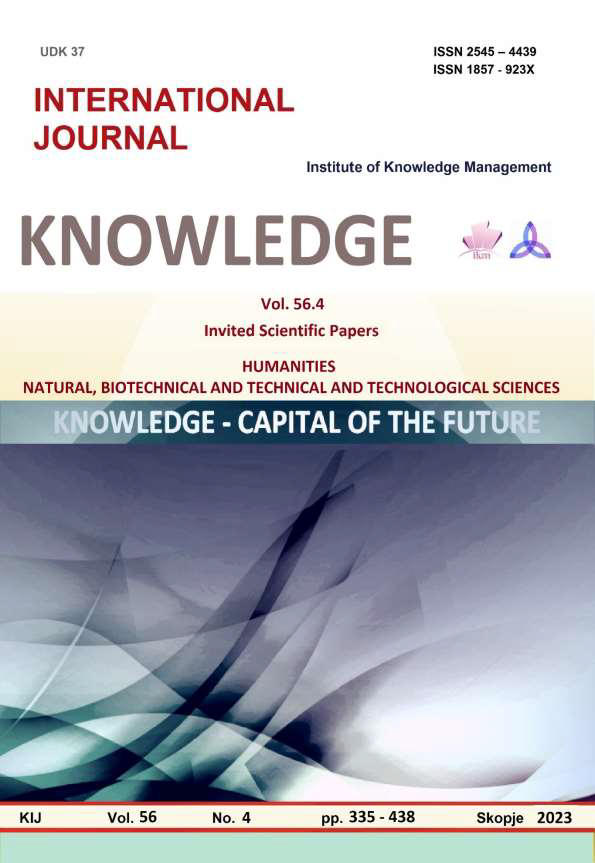EXTENDING THE CAPABILITIES OF THE SIMULINK EXPLORER
Keywords:
subsystem, masking, model, advantagesAbstract
This report presents a joint study on the advantages of the masking approach on the subsystem in
Simulink and the algorithm on the process. Tracing sa basic steps for sjdavane on the seer on the masked subsystem.
Directions are needed in practice to apply to masking subsystems in computer simulations, often from different
analyzes on electronic circuits. The preliminary preparation and features of applied masking of subsystems in
Simulink are followed. The aim is to support the engineering modeling of electronic devices and to expand and
optimize the possibilities of the researcher.
A model of a function generator is given when the source of the signal amplitude setting and the source of the signal
frequency setting are external, and the reasoning is analogous for other cases of dynamic updating of the input
effects. The masking mechanism is applied less often, but it allows the system to be formed as a full-fledged library
block. In addition to extending the user's ability to control model parameters with its own parameter window and
reference system, the subsystem masking library block has other advantages. It increases the reliability of the model
from unwanted modifications, expands the possibility of building complex models, improving their visibility. A
difficulty in performing the masking of any subsystem is the preliminary preparation, especially the determination of
the range of the parametric window. Setting these parameters using identifiers is shown.
During masking, access to other MATLAB tools remains open, even though Simulink is a standalone application.
When modeling, the user can choose a method for solving differential equations, also a method for changing the
model time (with a fixed or variable step). In the course of modeling, it is possible to monitor the processes
occurring in the system. For this, special monitoring devices included in the Simulink library are used. Modeling
results can be presented in the form of a graph or table. An advantage of Simulink is that it allows complementing
library blocks using subroutines written in both MATLAB and C++, Forttran and Ada languages.
References
Боянов, П.К. (2022). Програмиране в средата на MATLAB, Университетско изд.“К>Преславски“,Шумен, ISBN 978-619-201-591-6
Kaров, Д., & Kукуригов, Д. (2013). Моделиране и изследване на photovoltaic (pv) генератор в Мatlab/Simulink. компютърни науки и комуникации, BCУ, Бургас2(4), 47-51.ISSN 1314-7846
Toнчев, Й. (2013) Приложение на МАТLAB в инженерните изследвания,2 част, Университетско изд.„Ангел Кънчев“,Русе ISBN 978-954-712-593-3
Тончев, Й., & Витлеемов, В.Г. (2013). Оптимизация с МАТLAB.Прагматичен подход, Университетско изд.“Ангел Кънчев“, Русe, ISBN 978-954-712-593-3 ISBN 9783969172780
Acadi, F. (2022). Simulation of power electronics circuits of Matlab/Simulink, Apress Berkeley, CA, .ISBN 978-1-4842-8220-5
Alassoulu, K.M.(2020). Simulation of Some Power Electronics Case Studies in Matlab Simpowersystem Blockset, Cobo plus, ISBN 9783969172780
Bejan, A. (2019). Advanced engineering thermodynamics. New York: John Wiley and Sons Inc.,
Gonzales, R.C., & Woods, R.F. (2008). Pearson Education Limited, ISBN 9780982085400
Huang, Z.F., & Tan, K.H. (2020). Structural response of a steel beam with a frame during a fire. In: Proceedings of the third international conference on advances in steel structures, vol. II, p. 1111-1118.
Manias, S.(2020). Simulation of power electronics circuits using PSIM, PSPICE or MATLAB/SIMULINK,,Buskar Amazon, ISBN 979-8645073572
Preis, H. (2020). Matlab/Simulink 2.A, Carl Hanzer Verlag Gmb &Co,ISBN 9783446442696
Van Loan, C.F. (2017). Introduction to scientific computing: a matrix-vector approach using MATLAB. N. Y. Prentice Hall





